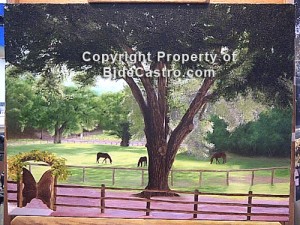 I worked the details on the oak tree trunk using the darkest values. I mixed burnt umber and burnt sienna for the darkest darks. Then I added a touch of titanium white to accentuate the bark high spots. After this dries, I will come in and accent the finest details with the lightest value, or highlights.
I worked the details on the oak tree trunk using the darkest values. I mixed burnt umber and burnt sienna for the darkest darks. Then I added a touch of titanium white to accentuate the bark high spots. After this dries, I will come in and accent the finest details with the lightest value, or highlights.
 Now I raise my canvas on my Best easel for the standing work. The canopy will require that I move in and out on my feet to keep check on the values and shapes.
Now I raise my canvas on my Best easel for the standing work. The canopy will require that I move in and out on my feet to keep check on the values and shapes.
I use a fairly large #6 bristle fan brush. I load tons of sap green on one end and ivory black on the other. This allows me to flip the brush from one end to the other quickly while I am shaping the canopy.
While my thick paint is still wet, I come back in with sap green and titanium white in varying mixes to adjust medium values and touch up any ‘see-through-the-tree-to-the-sky’ areas that got lost in my exuberant earlier brush work.
Finally, I mix dioxazine purple, ivory black, sap green and titanium white to lay in the dark, medium and light values of the dying branch on the backside of the tree. This was actually a whole tree between the foreground and background tree, which I removed from my painting. However, my favorite color in this painting was the lavendar of the sunlit dead branches, so I took some artist’s perogative and made it a dying branch of my main oak. Not yet drafted on the canvas…will be some beautiful lavendar flowers in foreground corners in front of the upfront fencing to tie it all in.

